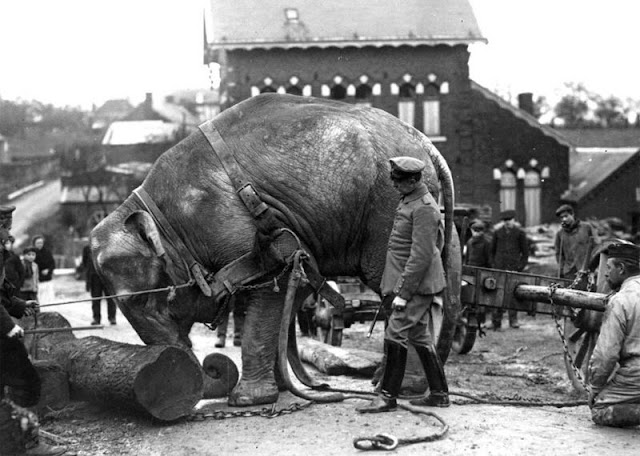Over 16 million animals served in the First World War. They were used for transport, communication and companionship.
In 1914, both sides had large cavalry forces. Horse and camel-mounted troops were used in the desert campaigns throughout the war, but on the Western Front, new weapons like the machine gun made cavalry charges increasingly difficult.
 |
| The feline mascot of the light cruiser HMAS Encounter, peering from the muzzle of a 6-inch gun. |
However, animals remained a crucial part of the war effort. Horses, donkeys, mules and camels carried food, water, ammunition and medical supplies to men at the front, and dogs and pigeons carried messages. Canaries were used to detect poisonous gas, and cats and dogs were trained to hunt rats in the trenches.
Animals were not only used for work. Dogs, cats, and more unusual animals including monkeys, bears and lions, were kept as pets and mascots to raise morale and provide comfort amidst the hardships of war.
 |
| A single soldier on his horse, during a cavalry patrol in World War I. |
 |
| “These homing pigeons are doing much to save the lives of our boys in France. They act as efficient messengers and dispatch bearers not only from division to division and from the trenches to the rear but also are used by our aviators to report back the results of their observation”. |
 |
| Bandages retrieved from the kit of a British Dog, ca. 1915. |
 |
| A dog-handler reads a message brought by a messenger dog, who had just swum across a canal in France, during World War I. |
 |
| Red Crescent Hospital at Hafir Aujah, 1916. |
 |
| A draft horse hitched to a post, its partner just killed by shrapnel, 1916. |
 |
| Horses requisitioned for the war effort in Paris, France, ca. 1915. |
 |
| A soldier and his horse in gas masks, ca. 1918. |
 |
| A message is attached to a carrier pigeon by British troops on the Western Front, 1917. One of France’s homing pigeons, named Cher Ami, was awarded the French “Croix de Guerre with Palm” for heroic service delivering 12 important messages during the Battle of Verdun. |
 |
| A corporal, probably on the staff of the 2nd Australian general hospital, holds a koala, a pet or mascot in Cairo, in 1915. |
 |
| Serbian artillery in action on the Salonika front in December of 1917. |
 |
| Western Front, shells carried on horseback, 1916. |
 |
| Australian Camel Corps going into action at Sharia near Beersheba, in December of 1917. The Colonel and many of these men were killed an hour or so afterward. |
 |
| A messenger dog with a spool attached to a harness for laying out new electric line in September of 1917. |
 |
| Belgian refugees leaving Brussels, their belongings in a wagon pulled by a dog, 1914. |
 |
| 6th Australian light-horse regiment, marching in Sheikh Jarrah, on the way to Mount Scopus, Jerusalem, in 1918. |
 |
| Turkish cavalry exercises on the Saloniki front, Turkey, March of 1917. |
 |
| The breakthrough west of St. Quentin, Aisne, France. Artillery drawn by horses advances through captured British positions on March 26, 1918. |
 |
| German officers in an automobile on the road with a convoy of wagons; soldiers walk along side the road. |
 |
| A dog trained to search for wounded soldiers while under fire, 1915. |
 |
| Belgian Army pigeons. Homing pigeon stations were set up behind the front lines, the pigeons themselves sent forward, to return later with messages tied to their legs. |
 |
| Gas attack on the West Front, near St. Quentin 1918—a German messenger dog loosed by his handler. |
 |
| Two soldiers with motorbikes, each with a wicker basket strapped to his back. A third man is putting a pigeon in one of the baskets. In the background there are two mobile pigeon lofts and a number of tents. The soldier in the middle has the grenade badge of the Royal Engineers over the chevrons which show he is a sergeant. |
 |
| Unloading a mule in Alexandria, Egypt, in 1915. |
 |
| Camels line a huge watering station, Asluj, Palestinian campaign, 1916. |
 |
| French cavalry horses swim across a river in northern France. |
 |
| General Kamio, Commander-in-Chief of the Japanese Army at the formal entry of Tsing-Tau, December, 1914. |
 |
| A pigeon with a small camera attached. |
 |
| German Red Cross Dogs head to the front. |
 |
| Belgian chasseurs pass through the town of Daynze, Belgium, on the way from Ghent to meet the German invasion. |
 |
| German soldiers pose near a horse-mounted with a purpose-built frame, used to accommodate a captured Russian Maxim M1910 machine gun complete with its wheeled mount and ammunition box. |
 |
| Algerian cavalry attached to the French Army, escorting a group of German prisoners taken in fighting in the west of Belgium. |
 |
| An Indian elephant, from the Hamburg Zoo, used by Germans in Valenciennes, France to help move tree trunks in 1915. |
 |
| Members of the Royal Scots Greys cavalry regiment rest their horses by the side of the road, in France. |
 |
| War animals carrying war animals — at a carrier pigeon communication school at Namur, Belgium, a dispatch dog fitted with a pigeon basket for transporting carrier pigeons to the front line. |
(via
Rare Historical Photos,
Imperial War Museums)












































0 comments:
Post a Comment